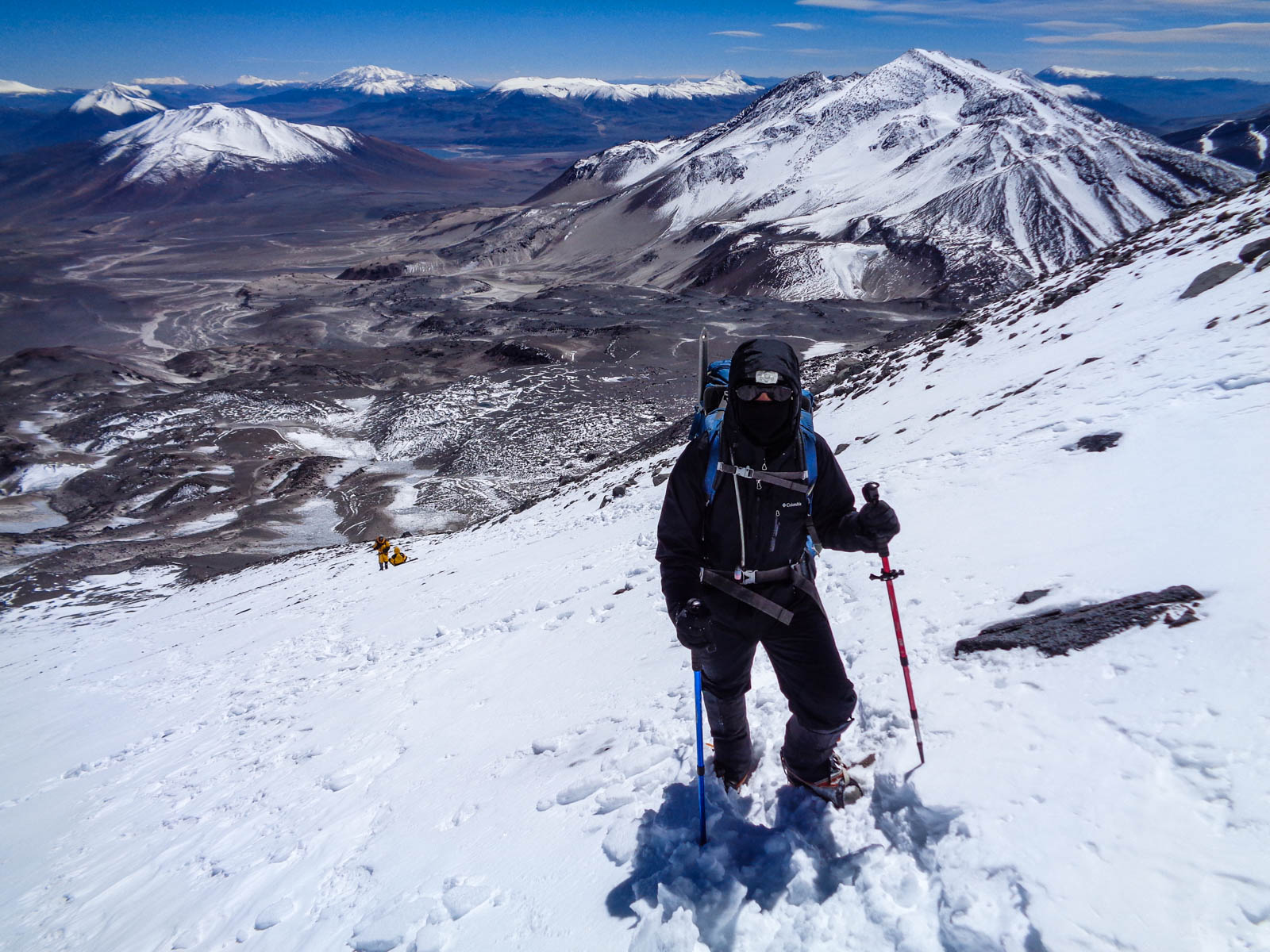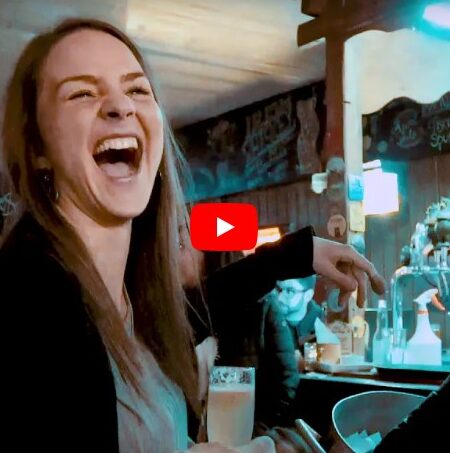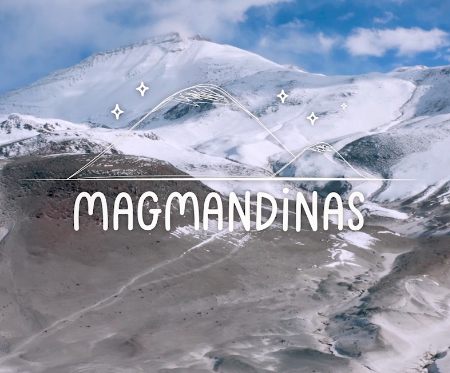Climbing the Volcano Ojos del Salado in Northern Chile is a unique and memorable experience. Ojos del Salado is the tallest volcano in the whole world, the tallest peak in Chile, and the 2nd tallest peak in South America, right behind Aconcagua. It is the one of the 7 volcano summits.
It is typically climbed November to March and takes 8-10 days, unless you’re previously acclimated. Plan with caution during January and February since the region faces a High Plateau winter phenomenon.
–
Well, I came back a bit early from my trip to the tallest volcano in the world, Ojos del Salado. I came back without a summit but with a renewed awe for this world, a great experience in my books, and confidence that every trip makes me stronger and smarter. We made it to 21,500 feet before heading down and I’m looking forward to the day I can go back to see its summit.
Not summitting was not easy, but who am I kidding. When is it easy to not meet your goal? Although, I learned a lot from this experience, and these lessons will serve me not just in the mountain, but in life. The whole experience was unique and awesome, so here it goes.
Fun facts about Ojos del Salado Volcano
- The Volcano Ojos del Salado in Northern Chile towers at 22,600ft / 6893m. It is the tallest volcano in the world and second tallest peak in South America, juuuuust behind Aconcagua.
- Like Aconcagua is one of the Seven Summits, a circuit of the tallest mountains on each continent; Ojos del Salado is on the other list of 7 summits, the “7 volcano summits”, which are the tallest volcanoes on each continent.
- Ojos del Salado is very, very remote and still has a feeling of “undiscovered.” While many famous routes are filled with traffic jams on the summit, here, you’ve got a 99% chance that you’re group is the only one. And, hey, you might even have the volcano all to yourself!
- It is typically done in 8-10 days, depending on your acclimitization, where you’re coming from, etc. For us in Chile, it’s a bit easier because we have the Andes as a playground and can do many prep routes to make our actual time on Ojos del Salado shorter. Weather and wind can be very extreme on Ojos del Salado.
- While it true that you can get up to 5200m (Atacama shelter) or even 6000m (Tejos Shelter) in vehicle, depending on terrain conditions, your vehicle, and your driving skills, a very common, and dangerous, mistake is thinking that makes this climb “easy”. Proper acclimatization cannot be rushed! And, the Mountain Sickness in the north of Chile is different, and stronger, than in other places, so do not under-estimate this.
Note: Efficiently acclimating is done by gradually rising in altitude. You should be exercising in higher altitude (ie: climbing mountains) to help you body adjust. Then, you climb back down and sleep at a lower altitude. Repeating this process over days, as you continue to advance, will help you have a safe, enjoyable, and successful climb.
”You can get up to 5820 m / 19000 ft of elevation in vehicle on Ojos del Salado…but respect your acclimatization process or you’ll regret it.
Chelsey Berg
How do you get to Ojos del Salado from Santiago?
The long journey North to Copiapo
To get to the base of the mountain, we needed to head to Copiapo, a mining town about 10 hours north of Santiago. We decided to drive, because it was easier for us to just throw all our gear in the back of the pickup and take turns driving. If you fly from somewhere else to Chile, then you can just book another flight from The Santiago airport to the airport in Copiapo.
My friends picked me up early Friday morning and I loaded my gear into the pickup. About an hour after getting on the road, we stopped at Los Hornitos (the little ovens) in Llayllay for hands down, the best breakfast in the world! I recommend this place for all hungry people heading North from Santiago on the Interstate / Highway 5. Stepping out of the truck, burning wood filled our noses and made our bellies growl.
The restaurant is open air (but with a roof) and has dirt floors, with a big brick grill filled with chicken, beef, sausages and pork cooking over its hot coals; a wood burning stove was on the right, with big old style pots and teapots boiling water and milk for tea and coffee; and a coal burning cooking area in the middle, made from bricks and with hot coals in the middle, with a basket of farm eggs and little self-serve skillets for you to make your eggs with. Oh, and I can’t forget the recently made, country style, homemade bread. Can you smell it?
We walked in, picked up two fresh breads each, placing them over the grill to toast, headed over and put two eggs in our personal skillets, seasoned the eggs as we wanted while they cooked over the hot coals, and then picked up a mug to go serve ourselves some coffee. Talk about breakfast of champions!! It was awesome, and just as tasty as it was cool, the perfect way for us to get ready for the climb ahead.
Since Chile is so costal, almost the entire trip up north is with an ocean view. We stopped for a mini lunch, indulging on seafood empanadas. Empanadas are dough filled with different ingredients, based on what you want. Since we were in the North of Chile, where seafood is so good, we had cheese/scallop, cheese/crab, and cheese/clam empanadas. The seafood ones typically are mixed with cheese. Can you say, yuuuuuummy? Our butts were tired so we stretched and walked on the beach a bit before heading on.

Planning for water and signal on Ojos del Salado Volcano
We eventually got to Copiapo, a loooong 540 miles from Santiago, and headed to the grocery store to get all the food and water we needed for the climb. There is no water on Ojos del Salado, as the Atacama Desert is the most arid desert in the whole world. It’s possible you will have snow for melting, once you’re up past the Tejos shelter, but it depends on the season. We had tons of snow but I also know people who summited with a completely dry ascent. Anways, better to be safe than sorry, we estimated 20 liters of water for each person.
Once arriving to Copiapo, whether you drive or fly, it’s good to spend the night for these kind of errands and to unwind from all the transport and logistics. If you’re coming from outside of Chile, I’d reccommend hiring a mountain guide service not only for help on the mountain, but because getting from Copiapo to the volcano Ojos del Salado is a bit tricky. Going with a guide, they will transport you to and from.
Otherwise, you’ll need to rent a highly reliable 4×4 and have the route already loaded in your GPS. There is no signal of any type of Ojos del Salado!! And, while it’s an awesome mountain, it’s still a bit of a hidden gem. If you’re used to climbing other mountains and getting to the nearby town and having a million places to get information and make coordinations, you are in for a surprise. There is no public transport or any easy way to get to the mountain without your own 4×4 or a hired guide. Also, a satellite phone is recommended.

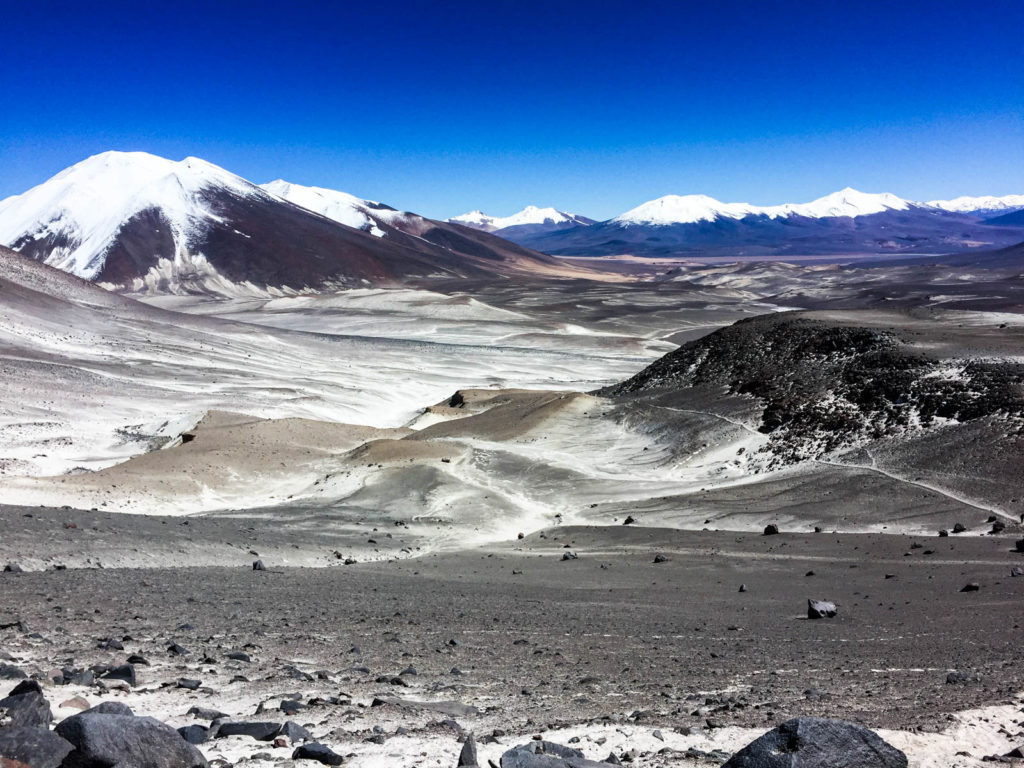


Getting from Copiapo to Ojos del Salado Volcano
Saturday morning (Day 2) we headed out early for the mountain. The drive was a quick reminder that indeed, this desert is dry. No vegetation, just dirt, brown and mountains in every direction, plus a beating sun. The speccial aspect of this kind of terrain, something very unique to Northern Chile, is that you can advance very high into the mountains in your 4×4 vehicle. Here’s a GPS route from Copiapo to Ojos del Salado.
A couple hours and 180 miles into the drive, we came across a a surprise. In the middle of the dry, brown, arid desert popped up a big, white oasis.
And, suddenly, it became clear why this volcano is called “Eyes of the Salt Flat” (Ojos del Salado).
It had un-characteristically rained recently, which left gorgeous mountain reflections across the sprawling white Maricunga Salt Flat. I stared at the mirrored images of the peaks in the distance as I walked along the salt crackling below my feet, happening upon four petrified rats (eeew) that must’ve gotten stuck in the salt. After so much time in the truck, it was fun to play around with the reflections, take pictures, and move around.
A couple hours later along the dirt road, we stopped at a gorgeous lake, the Santa Rosa lagoon. There’s not many lakes scattered throughout this desert, and I’m not sure how they maintain with the heat, but again, here we were in a little paradise of color amidst all the brown. It’s normal to see guanacos, flamingos, birds and other animals.
The green-grey-bluish water was surrounded by yellow, straw like bushes, which were complemented by snowcapped colorful peaks in the distance and a crystal blue sky. We sat down here and made some tea and had lunch.
Depending on your acclimatization, some people use Santa Rosa, at 3600m / 11800ft, as the first camp for Ojos del Salado. If this is best for you, then you could climb the “Siete Hermano / 7 Brothers” mountain nearby.
However, we had been doing many acclimatization routes, like El Plomo mountain near Santiago, so we decided to continue further. Another 100 miles later, we arrived to the the Laguna Verde lagoon, where we would camp for the first night at 4200m / 14,000 feet.

A GUIDE BY YOUR SIDE (AND IN YOUR INBOX)
My “Word Cairns” newsletter sends inspiration, tips, stories, and photos from wild corners of this world. Plus, you’ll be the first to know about new expeditions, activities, and special offers.
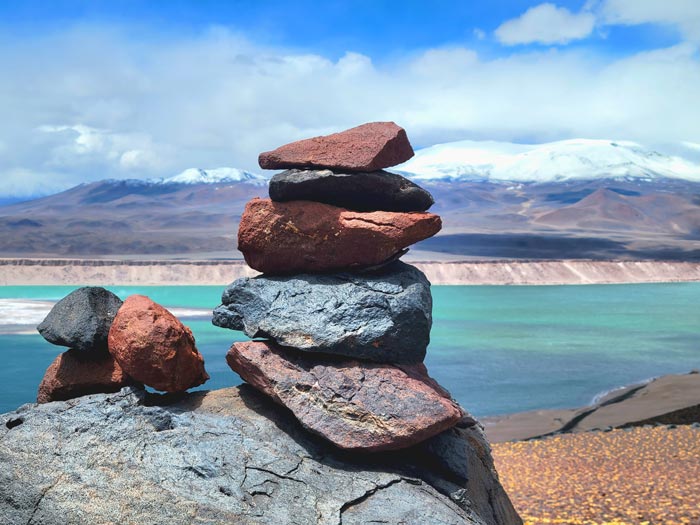
Climbing Ojos del Salado Volcano
Camp 1 – Laguna Verde: 4200 m / 14,000 ft
Camping at Laguna Verde is wonderful because there are many surrounding mountains to climb and aid your acclimatization, ranging from 18,000 to 20,000 feet. The idea here is to climb those mountains for a day or two. The Mulas Muertas / Dead Mules Mountain, at 5897m, is a popular climb from Laguna Verde.
Note: Some people like to sleep at the Murray shelter, just a 10ish kilometers from Laguna Verde. Totally your call. We enjoyed the view and contrasting colors at Laguna Verde
The Laguna Verde lake is gorgeous!! It is a deep royal blue with red sands around it and snow covered peaks in the distance. At precise moments in the morning and evening we got another gift of a mirrored mountain reflection over the water. Also, there are multiple hot springs!!
That first night, I slept like a baby, all warm and snug in my sleeping bag even though it was probably hovering around 15F / -10C.
Climbing Ojos del Salado Volcano
Camp 2 – Atacama: 5200 m / 17,000 ft
The next camp for Ojos del Salado is Camp Atacama, with an altitude of 5200m /17,000 feet. You drive from Laguna Verde to Camp Atacama and the idea is to spend a few nights here. Our plan was 3 nights, based upon our acclimatization needs.
The route from Laguna Verde to Camp Atacama is pure dirt, mountain terrain. There is no road and it is very easy to lose your way. You climb 1000m / 3000ft and the dirt roads are not easy. This is why you need a reliable 4×4 and a downloaded GPS!!
Upon arrival, we met two guides who were there with Paul, an English man acclimating for Everest!! (ps. he summitted!) They were a really cool group and we got along awesome. Following the customs of normal mountain life, we developed quick, great relationships between our groups. Not to mention, we were the only ones on the mountain. Later, one of the guides, Luciano Badino, helped give us tips which were key for our later Aconcagua summit.
That first day at Camp Atacama, we set up our tents and then carried water up to Camp Tejos. The trekking from Camp Atacama to Camp Tejos is about 3 hours and very important for acclimatization.
The sun was beating but the wind was blowing. Even though it was middle of summer, up at this altitude, it still requires a couple base layers even during the day. We passed fields of penitentes, the “upside down icicles” that form on the ground. They were much bigger than me and very thin.
Once back down at Camp Atacama, I went to take pictures. The surrounding mountains are spectacular! They are very different than the other mountains in Chile, from the central Andes and veeery different from the low, but more technical and snow mountains in Southern Chile. It was crazy to see the flat desert and then grey and all shades of brown, but with snow caps. I’m not kidding, I felt like I was on the moon!
Mother Nature had other plans – bad weather was on the horizon.
Via their satellite telephone, Luciano, the guide with Paul the English man, got an unpleasant weather update. Bad weather was coming. It was Monday and the best day to summit was Tuesday. This was impossible for us. For one, we still needed to get to the next camp, Tejos.
But most importantly, our bodies weren’t ready. We all had slightlevels of Acute Mountain Sickness (AMS). Light headaches upon waking up, sometimes slightly during the day, and one in our group had vomited the day before. It would be dangerous and irresponsible to climb higher. So, we spent another night.
We ended up spending 2 nights in Camp Atacama, but had originally planned on three.
Climbing Ojos del Salado Volcano
Camp 3 – Atacama: 5820 m / 19,000 ft
Tuesday we made our final ascent with the rest of our gear to Camp Tejos (19000 ft), to spend the night there… it was summit day eve and we were blessed with another gorgeous sunset.
We were less acclimated than we wanted to be. I had an intense headache as I woke up, but that thankfully reduced to normal or light headache as my body got moving. Various others hadn’t slept much any of the nights. It was damn cold, around 10F / -10C during the day and much colder at night. But we decided to see how far we could get, but didn’t feel so positive about a summit.
We organized our “attack backpacks” – the backpacks you take to the summit, with all the safety gear, food, water, etc – and hit the sack early.
Ojos del Salado summit morning
3am rolls around quick. It was cooooold, but we made our tea, toasted bread over our camp stove, and organized. I had virtually no appetite and ate just because I knew I had to. This morning, I made two slices of wheat bread with peanut butter and jelly. It took me an hour to eat them.
We headed off… and up. It was a rough morning and we could tell our bodies weren’t ready. We moved slower and it took longer to get momentum. The ground was hard and the incline constantly steep, but the zig zag made it more manageable.
A couple hours in, the sun started to rise. We were around -8F/-20C with 30mph/40kph winds, but thankfully I was well layered and wasn’t too cold unless I stopped too long. A beautiful sunrise starting peeping over the mountains behind me. Periodically, I’d stop for 30 seconds at a time to look back and take the view in.
We eventually hit the snow, which unfortunately was soft from a recent snowfall. This made our steps much more consuming, often sinking up to or past our knees. That, without a doubt, was the worst.
I often felt like I wanted to scream as I sunk in, because it just consumed so much energy to lift myself out. But up and up we went, trudging along and through the snow. I felt inspired by the landscape both to the sides and below me. I didn’t have a headache, so that was good, but my fatigue felt much higher than normal.
Above it the white incline continued on and on, but below and in all my peripheral vision, I felt like it was another planet. It was so beautiful. Around 20,500ft we dug the heels of our crampons into the steep incline of the mountain to sturdy ourselves and sit for a rest. We were tired.
Then, something happened that sealed our fate, of the point of no return.
When we started getting up to get going again, my friend’s backpack slipped loose and rolled… and rolled… and rolled … down the mountain. In horror I just watched the red little dot get smaller and smaller until it vanished; it fell to a point that had probably took more than 4 hours to climb.
We all looked at eachother with eyes wide open. We were at 6550m / 21, 500ft and the summit was a few hours away. We had our crampons on, but later we’d need our ice axes and, right before the summit, our ropes/harnesses. And, all his gear had just slo-mo moled down the mountain. In all reality, it probably rolled pretty damn fast, but, our incredulous faces felt like it was slow motion.





Decision time
So, here we had to decide, does he/anyone else go down and others continue? Or, do we all go down together? We had enough food/water to share, but looking at the clock, we were about 45 minutes behind schedule. We’d moved slower due to the wind and snow.
We probably wouldn’t summit until after 3:30pm, when we originally wanted to summit around 2pm, and we knew that the wind was only going to get stronger as the afternoon went on. We were against the clock.
And, our muscles were fatigued. The reality is… the summit is only the half way point. You still need legs to get down, as a successful climb is when you all get down safely! All the factors taken into consideration, we disappointedly decided it was best to all head down together.
At first, I felt a big rush of sadness and disappointment. I wanted that summit! I had dreamed of that summit! I felt like I failed. I wan’t feeling very happy with my climb.
But then, as I turned around, I got a wake up call that hit me like a brick wall. All of a sudden, the mountains below filled my eyes and my body tingled before their truly one of a kind beauty. I had never seen mountains like these. I felt like it could have been a scene from the moon.
I stopped, shook off the bad attitude and breathed in slowly to really appreciate where I was. No matter what, summit or no summit, I was staring at this world from 21,500 feet.
Chelsey Berg
It was my first time at that altitude. The cold, the wind, the sun, the snow, the mountains, I took slow, deep breaths and loved the moment and place I was in.
I was staring at a world more beautiful than I could really comprehend, recognizing that I’m just a guest in Mother Nature, an ant crawling in all her magic.
The mountain will not move, I will go back, I will see the summit… and i didn’t want to let a different ending change my appreciation. Where I was, what I had done, was still nothing short of awesome.
So, I sighed, smiled, looked around, held the cross grandpa gave me and said “thank you.” Back to camp we headed, shedding layers as we dropped in altitude. I thought a lot about my disappointment and the importance of respecting that fine line of when to turn around.

Only in Chile
Breakfast in the mountains and lunch on the beach
When we got back to the truck, instead of camping that night, we decided to drive the 6ish hours into civilization. We had a glimmer of a bed, beer and hot shower in our heads. We enjoyed the beer, took in every drop of the hot shower and slept like babies in a hotel bed.
The next day, we leisurely drove the 10 hours back to Santiago, loving the ocean view and stopping at 5 different beaches along the way.
We got home at 4 in the morning. I opened my bedroom door, dropped my gear and backpack on the floor, and hopped into bed.
For about 10 minutes before falling asleep, I laid there, realizing it was all over.
It felt a bit heavy. I was home 3 days before I had planned to be and I didn’t have my summit… but I had a whole lot to be grateful for and a passion and appreciation for this world and my spot in it. I love the mountain and couldn’t wait to keep getting better and seeing more. That’s my North and I’m still on track.
Finding North Reflection
It’s not easy to halt the mission when you have goals, when you’ve been working towards something, or when you literally can see yourself accomplishing whatever it is you have in mind.
But, don’t undervalue the journey you lived to get to wherever you got. Surely, it was filled with growth, learnings, laughs and excited moments. Surely, the next time will be easier, because you’re perpspective will be different and experience much greater.
A halted mission is just a detour on the path to your North.
Related Articles

I'M TALKIN' TO YOU
Purpose-driven people who feel compelled to make life meaningful for yourself and others.
Outdoor-inspired people whose best self comes alive when experiencing beautiful places and pushing your limits in the open air.

